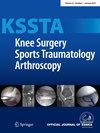在评估髌骨脱位时,股骨内翻角比TT-TG距离更有优势:一项回顾性队列研究。
IF 3.3
2区 医学
Q1 ORTHOPEDICS
引用次数: 0
摘要
目的本研究旨在报告与健康人相比,髌骨不稳患者的股骨内翻角(FAA)和胫骨结节-胫骨沟(TT-TG)距离的参数特征,并评估其预测髌骨脱位的可靠性,为截骨术提供潜在的适应症。方法回顾性收集连续的髌骨不稳患者作为研究组,无髌股关节疾病者作为对照组。通过下肢计算机断层扫描测量 FAA 和 TT-TG 距离,并记录有真正髌骨脱位的膝关节。使用接收器操作特征曲线和曲线下面积(AUC)评估 FAA 和 TT-TG 距离的诊断能力,通过敏感性和特异性确定病理值。研究组的 FAA(21.6 ± 9.0°)和 TT-TG 距离(20.1 ± 4.8 mm)明显大于对照组(分别为 10.6 ± 7.9°和 15.6 ± 4.6 mm)(P 18.2°)。此外,FAA和TT-TG距离每增加1°,髌骨脱位的风险分别增加18.5%和12.5%。外科医生应注意与旋转错位相关的髌骨脱位风险。本文章由计算机程序翻译,如有差异,请以英文原文为准。
Femoral anteversion angle is more advantageous than TT-TG distance in evaluating patellar dislocation: A retrospective cohort study.
PURPOSE
The purpose of this study is to report the parameter characteristics of the femoral anteversion angle (FAA) and tibial tubercle-trochlear groove (TT-TG) distance in patients with patellar instability compared to healthy individuals and to evaluate their reliability in predicting patellar dislocation, providing potential indications for osteotomy.
METHODS
A retrospective collection of consecutive patients with patellar instability constituted the study group, while individuals without patellofemoral disorder served as the control group. Measurement of the FAA and TT-TG distance were conducted by lower extremity computed tomography scans and knees with true patellar dislocation were recorded. The diagnostic capability of the FAA and TT-TG distance was assessed using receiver operating characteristic curves and area under the curve (AUC), determining the pathological values by sensitivity and specificity.
RESULTS
The FAA (21.6 ± 9.0°) and TT-TG distance (20.1 ± 4.8 mm) in the study group were significantly greater than the control group (10.6 ± 7.9° and 15.6 ± 4.6 mm, respectively) (p < 0.001). The AUCs for patellar dislocation were 0.869 for FAA and 0.712 for TT-TG distance, with pathological cut-off values of 18.2° and 18.2 mm, respectively. The odds ratios for FAA and TT-TG distance were 1.185 and 1.125, respectively (p < 0.05).
CONCLUSIONS
Patients with patellar instability exhibited significantly greater FAA and TT-TG distance compared to healthy individuals. The FAA demonstrated superior predictive capability for patellar dislocation compared to the TT-TG distance. The FAA (>18.2°) measured by surgical transepicondylar axis and TT-TG distance (>18.2 mm) were the potential pathological thresholds. Additionally, an increase of 1° in FAA and 1 mm in TT-TG distance was associated with a 18.5% and 12.5% increased risk of patellar dislocation, respectively. Surgeons should be aware of the risk of patellar dislocation associated with rotational malalignment.
LEVEL OF EVIDENCE
Level III.
求助全文
通过发布文献求助,成功后即可免费获取论文全文。
去求助
来源期刊
CiteScore
8.10
自引率
18.40%
发文量
418
审稿时长
2 months
期刊介绍:
Few other areas of orthopedic surgery and traumatology have undergone such a dramatic evolution in the last 10 years as knee surgery, arthroscopy and sports traumatology. Ranked among the top 33% of journals in both Orthopedics and Sports Sciences, the goal of this European journal is to publish papers about innovative knee surgery, sports trauma surgery and arthroscopy. Each issue features a series of peer-reviewed articles that deal with diagnosis and management and with basic research. Each issue also contains at least one review article about an important clinical problem. Case presentations or short notes about technical innovations are also accepted for publication.
The articles cover all aspects of knee surgery and all types of sports trauma; in addition, epidemiology, diagnosis, treatment and prevention, and all types of arthroscopy (not only the knee but also the shoulder, elbow, wrist, hip, ankle, etc.) are addressed. Articles on new diagnostic techniques such as MRI and ultrasound and high-quality articles about the biomechanics of joints, muscles and tendons are included. Although this is largely a clinical journal, it is also open to basic research with clinical relevance.
Because the journal is supported by a distinguished European Editorial Board, assisted by an international Advisory Board, you can be assured that the journal maintains the highest standards.
Official Clinical Journal of the European Society of Sports Traumatology, Knee Surgery and Arthroscopy (ESSKA).

 求助内容:
求助内容: 应助结果提醒方式:
应助结果提醒方式:


